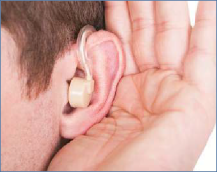< Previous | Contents | Next >
Deaf and Hard of Hearing

A hearing impairment is a condition involving the entire range or spectrum of hearing loss. Deafness refers to a severe hearing loss, and a person suffering from it may use sign language, speech reading, and other non-verbal means of communication. “Hard of hearing” refers to a less severe condition of hearing loss. The main mode of communication for a person hard of hearing may be audio-verbal. Students who are deaf or hard of hearing tend to define themselves by their choice of communication. It is not uncommon however to encounter students who are hard of hearing using sign language or students who are deaf preferring oral communication. Signs of hearing loss include the following behaviors:
Giving inappropriate responses
Speaking in an unusually loud or soft voice
Not hearing or responding when someone speaks from behind
Appearing to pay attention but not actively participating in class discussions
Asking for something to be repeated
Responding with smiles and nods but no further comments
Withdrawn, introverted, shy, or, conversely, demanding and frustrated behavior
Immature or awkward social skills
Broad range of communication systems, from exclusively manual sign language to exclusively spoken language and all variations in- between
Functional Limitations
Hearing loss ranging from mild to profound
Relying on visual cues
Miscommunications
Limitation in effective hearing, speaking, reading, and writing communications
Accommodations
In order for their accommodation services to be fully effective, deaf and hard-of-hearing students require professors to be sensitive and responsive to their needs so that they can fully participate in the educational experience.
Individuals who are deaf and hard-of-hearing use a variety of devices, such as hearing aids and cochlear implants, and strategies, such as lip reading, to augment their aural and communication abilities. Offices of disability services provide accommodations such as:
Such assistive listening devices (ALD), as infrared, FM, or audio loops
Sign language/oral interpreters
Captioning
Note-takers
Extended time on exams
Teaching Strategies
Be natural when working with a sign language interpreter.
Allow the student to sit where he can most easily see you, the interpreter, and the board or screen simultaneously
Be aware that the interpreter lags slightly behind the speaker and that any comment by the student is also a few minutes behind. It is important to give time for the student to catch up so that any question can be clarified before the topic has passed
Provide copies of the syllabus, PowerPoint presentations, or other handouts for the interpreter, captionist, or note-taker in as far advance as possible
Have all audio/visual media, such as movies, DVDs, video, visual/audio internet media, captioned or subtitled
Remember that a student with a hearing loss cannot watch someone speak or sign while something is being demonstrated
Talk and listen directly to the student, not to the sign language interpreter or listening device
Lecture from the front of the room, and do not pace around.
Do not obscure your face or mouth (e.g., with hands, mustache and/or beard, or a face covering)
Do not speak while writing on the board
Identify who is speaking during classroom group discussion
Repeat or rephrase questions or comments from the class before responding
Avoid incomplete sentences, colloquialisms, and slang
Avoid prolonged pauses in your sentences
Do not exaggerate the speed or enunciation of your speech as this distorts the lip patterns
Repeat and then paraphrase if the student does not understand
Provide a note-taker and/or copies of notes and transparencies, since most students who are deaf or hard of hearing cannot take notes while they are lip reading or watching an interpreter
Limit the amount of background noise

Our Sources and Additional Resources:
PEPNet2: The Americans with Disabilities Act (ADA): Responsibilities for Postsecondary Institutions Serving Deaf and Hard of Hearing Students: Questions and Answers Book—2nd edition:
http://www.pepnet.org/resources/ADAQA2ndEdition
PepNet2 Tipsheets:
http://www.pepnet.org/search/node/PEPNet Tipsheet
Hearing Impairment (University of Calgary):
http://www.ucalgary.ca/access/instructors/hearing
Registry of Interpreters of the Deaf:
http://rid.org/
Center for Hearing and Communication:
http://www.chchearing.org/
National Association of the Deaf:
http://nad.org/
Hearing Loss Association of America:
http://shhh.org/
< Previous | Contents | Next >


